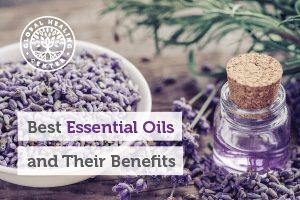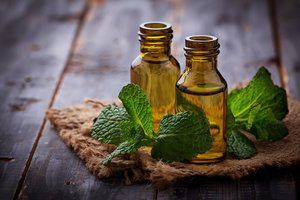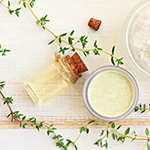
Essential oils, also called volatile oils, are scented oils extracted from plants. Historically, they've been used in medicine, cosmetics, perfumes, food, and, more recently, aromatherapy. Essential oils contain the “essence” of the plant, meaning the taste or odor.[1]
Not only are essential oils popular, but they also have legitimate therapeutic uses — and the science to back them up.[2] Although the exact benefit depends on the oil in question, some have antimicrobial and anti-inflammatory properties. Others can affect cognitive function, mood, and memory. Some can even help alleviate stiff, sore muscles and joints.
Some essential oils can be applied to the skin, others are best taken orally. However — and this is important — do not ingest or topically apply any essential oils unless you are absolutely certain that they can be used this way. Not all essential oils are safe to take internally and some can irritate the skin. Essential oils are a concentrated source of many phytochemicals and some essential oils must be diluted with an unscented "carrier oil" to be used safely on skin.
Health Benefits of Common Oils
One of the primary benefits of essential oils is that, when used properly, they offer many benefits and have few, if any, side effects. Many essential oils are effective against harmful organisms. Some can positively affect your mood and mental state. Some essential oils can even help you reduce a headache or feelings of nausea.
Aromatherapy uses essential oils to improve quality of life and reduce unpleasant side effects of aggressive therapies and health conditions.[3] Just be careful not to spill them; some surfaces, like painted wood, may react with essential oils.
Lavender Oil
Derived from fresh lavender flowers, lavender oil is one of the most well known essential oils. It appears to slow the activity of the central nervous system, improve sleep quality, promote better concentration, and help encourage hair regrowth in those suffering from alopecia areata, a type of hair loss.[4]
Lavender may also help counter anxiety. In one study, encapsulated lavender oil was found to be effective for generalized anxiety disorder, without sedative effects or potential for abuse.[5]
Eucalyptus Oil
Eucalyptus oil, derived from the leaves of Eucalyptus odorata, a smaller variety of eucalyptus tree, is a powerful biocide. It’s antimicrobial, insecticidal (kills insects), herbicidal, acaricidal (kills ticks and mites), and nematicidal (kills nematodes).[6] It's especially effective against the bacterial strains Staphylococcus aureus, Haemophilus influenzae, Staphylococcus agalactiae, and Streptococcus pneumoniae.[7]
Eucalyptus oil is great for respiratory health. Inhaling eucalyptus steam can help alleviate a cough or congestion. The aroma of the oil acts as an expectorant, helping to loosen phlegm in the nasal passages and lungs.[8]
In one study, researchers found that the combination of eucalyptus oil and peppermint oil boosted cognitive performance. The same study also found the scent of these two essential oils reduced headaches and promoted mental and muscular relaxation.[9]

Peppermint Oil
Peppermint essential oil can help alleviate nausea,[10] headache,[9] upset stomach, gas, indigestion, and anxiety.[11] It works on the digestive system by speeding up the rate of elimination.
Peppermint oil calms the involuntary smooth muscle of the stomach, producing an antispasmodic effect, and improves the flow of bile. It can soothe discomfort associated with irritable bowel syndrome (IBS) and studies have shown that encapsulated peppermint oil can reduce IBS symptoms in nearly 80 percent of people who take it.[11] Peppermint oil is effective because it contains menthol that interferes with the movement of electrolytes across cell membranes, stopping involuntary contractions.[12]
Beyond digestive help, peppermint oil may offer relief for HSV-1 (Herpes simplex virus) outbreaks by permeating the skin and acting as a virucide directly on the virus.[13]
Tea Tree Oil
Tea tree oil is another essential oil with strong antimicrobial properties. Also known as melaleuca oil, tea tree oil comes from “tea” or “paperbark” trees.[14] In Australia, it has a long history of use as an antiseptic. Bundjalung aborigines native to Australia inhaled the aroma of crushed leaves to relieve cough and used poultices to help heal wounds.
Today, we know that tea tree oil is antibacterial, antifungal, antiviral, and antiprotozoal.[14] It fights harmful organisms by damaging cell membranes.[15] Tea tree oil also inhibits the growth and sporulation of yeast and fungus. The oil can be applied topically to cuts to discourage infection.[14]
Like peppermint oil, tea tree oil seems to have an effect on HSV-1. One study revealed that, while topical tea tree oil doesn’t prevent recurrent herpes outbreaks, it may reduce viral load by up to 98.2 percent.[14]
Jojoba Oil
Jojoba oil is derived from the seeds of the wild jojoba shrub, a small, woody desert plant native to Arizona, California, and northwestern Mexico. Historically, Native Americans used jojoba oil to help wounds heal. Jojoba oil contains unique fatty acids and fatty alcohol esters that are similar, but superior, to those found in sperm whales for use in cosmetics.[16]
Unlike other essential oils, jojoba oil is not a volatile oil, but still offers plenty of benefits, primarily to the skin.[17] Researchers found that jojoba oil accelerates the closure of wounds at a cellular level.[18] To improve skin appearance and reduce acne, incorporate jojoba oil into your skincare routine. Evidence indicates that clay-jojoba oil facial masks might be an effective remedy for mild acne.[19]
Blue Chamomile Oil
Blue chamomile oil is extracted from German chamomile. The vibrant color of blue chamomile oil is a result of the steam extraction process — the azulene content in the oil darkens to an inky blue, brilliant azure, or deep green. This color fades and turns dark yellow during storage.
Chamomile has been used therapeutically for thousands of years by Greeks, Romans, and Egyptians to remedy everything from skin conditions and injuries to fever and insomnia.[20, 21] As a traditional medicine, blue chamomile oil may help with eczema, wounds, bruises, burns, canker sores, mastitis, and other conditions.[22]
Chamomile is also appreciated for its anti-inflammatory effects. One study found that chamomile inhibits and prevents a chemical process in the body that incites inflammation.[23] Further, chamomile seems to inhibit the effects of the stomach-ulcer-provoking bacteria Helicobacter pylori.[22]
Chamomile tea can help with insomnia, and inhaling the aroma of chamomile oil produces a mild sedative effect on the brain, which makes you feel sleepy. Like lavender, chamomile oil offers a mild anti-anxiety effect for those who suffer from generalized anxiety disorder.[22]
Rose Oil
Rose oil is a floral-scented essential oil derived from the petals of several rose varieties. In contrast, rose absolute is not an essential oil because the essence of the rose is extracted using a more intense chemical extraction processes. Like other essential oils, rose oil promotes a calm mood and fights harmful organisms.[24] It contains tocopherol (a vitamin E compound), carotene, and high levels of phenolic compounds.[25] Rose oil can make your skin more permeable[26] so it’s often added to skin care products to improve efficacy.
Oregano Oil
While not your typical "essential oil" that we think of for brightening the smell of a room, oregano oil contains carvacrol, a powerful organic compound with a long list of beneficial properties, including fighting harmful organisms.[27] Carvacrol also supports liver health.[28]
Jasmine Oil
Jasmine oil is derived from jasmine flowers. While many of the essential oils mentioned are sleep aids and relaxants, jasmine oil has a stimulating effect. When applied topically, jasmine oil increases alertness, breathing rate, and vigor. These effects may promote an uplifted mood and better sense of well-being.[29]
Copaiba Oil
Copaiba oil is extracted from the Amazonian plants in the Copaifera genus.[30] Copaiba oil contains copalic acid, which seems to halt the growth of common, but harmful, dental bacteria such as Streptococcus pyogenus, Streptococcus salivarius, and Streptococcus mutagens.[31] Copaiba oil also has strong anti-inflammatory effects. Copaiba oil also helps prevent or alleviate swelling in the body.[32]

Bergamot Oil
Bergamot oil is known for its calming effects,[33] but it may also encourage a healthy body weight and help with vascular and heart health.[34] Researchers aren’t yet sure how, but bergamot oil encourages normal cholesterol levels and blood sugar.[34]
Neroli Oil
Neroli oil is derived from the blossom of Citrus aurantium, also known as the bitter orange tree, which is native to tropical and subtropical Asia. The oil goes by many names but is frequently called “orange bitters” and “Seville orange.” It’s known as Neroli because a 17th-century Italian princess, Anne Marie Orsini of Nerola, took a liking to the scent.[35] Neroli oil is commonly added to diet pills due to it's ability to act as an appetite suppressant.[35] One of the major benefits of Neroli oil is that it helps relieve symptoms associated with menopause and stress.[36] It also boosts the actions of the endocrine system, fights harmful organisms, and soothes irritation.[35] It's sometimes added to natural skin care products.
Valerian or Lemon Balm Oil
Also called valerian, lemon balm is another essential oil that helps with symptoms of menopause, especially disordered sleep patterns.[37] Lemon balm also seems to sharpen memory and boost problem-solving abilities. Some promising research indicated that eugenol — a compound in lemon balm oil — may improve recall for laboratory rats with Alzheimer’s disease when used in conjunction with acupuncture.[38]

Pomegranate Oil
Pomegranate oil comes from the many seeds of the pomegranate. It's exceptionally rich in linolenic acid, an essential fatty acid. Some research suggests pomegranate oil may even delay the development of colon cancer[39] and skin cancer.[40] The oil also enhances the immune system.[41]
Frankincense Oil
Frankincense oil is extracted from Boswellia tree sap and has a long history of therapeutic use.[42] Most famously, frankincense was one of the gifts of the Wise Men at the first Christmas. Research shows that it promotes normal cell growth.[43]
How to Use Essential Oils
Most essential oils are safe to use, but you have to pay attention to their intended use and stick to those applications. Some oils can only be used aromatically and should not be applied to the skin or taken orally. You may have noticed that many of the oils are effective against harmful organisms. Those effects aren’t always limited to harmful organisms — they might affect gut and skin microbiota, too. Others can kill cells indiscriminately, including normal tissue cells.[44]
There are, of course, gentle essential oils that are great for the skin. Neroli oil, for example, acts as an antioxidant, calms the sensory nervous system, and soothes irritation. Rose oil moisturizes the skin and is used as a gentle toner. To take advantage of some of the skin benefits of essential oils, Glow contains Neroli, rose, jasmine, and lavender oil. It encourages healthy-looking, radiant skin and promotes well-being.
References (45)
- Korać RR, Khambholja KM. Potential of herbs in skin protection from ultraviolet radiation. 2011;5(10):164–173.
- Firenzuoli F, et al. Essential oils: new perspectives in human health and wellness. Evid Based Complement Alternat Med. 2014;2014:467363.
- Aromatherapy With Essential Oils (PDQ®). PDQ Cancer Information Summaries. 2002. Bethesda, MD:National Cancer Institute.
- Hay IC, et al. Randomized trial of aromatherapy. Successful treatment for alopecia areata. Arch Dermatol. 1998 Nov;134(11):1349–1352.
- Woelk H, Schläfke S. A multi-center, double-blind, randomised study of the lavender oil preparation silexan in comparison to lorazepam for generalized anxiety disorder. Phytomedicine. 2010 Feb;17(2):94–99.
- Batish DR, et al. Eucalyptus essential oil as a natural pesticide. For Ecol Manage. 2008;256(12):2166–2174.
- Elaissi A, et al. Chemical composition of 8 Eucalyptus species' essential oils and the evaluation of their antibacterial, antifungal and antiviral activities. BMC Complement Altern Med. 2012 Jun 28;12:81
- Silva SM, et al. Essential oils from different plant parts of Eucalyptus cinerea f. Muell. Ex benth. (Myrtaceae) as a source of 1,8-cineole and their bioactivities. Pharmaceuticals. 2011;4:1535–1550.
- Gobel H, et al. Effect of peppermint and Eucalyptus oil preparations on neurophysiological and experimental algesimetric headache parameters. Cephalalgia. 1994;14(3):228–234.
- Tate S. Peppermint oil: a treatment for postoperative nausea. J Adv Nurs. 1997;26(3):543–549.
- Cash BD, et al. A novel delivery system of peppermint oil is an effective therapy for irritable bowel syndrome symptoms. Dig Dis Sci. 2016;61:560–571.
- Grigoleit HG, and Grigoleit P. Pharmacology and preclinical pharmacokinetics of peppermint oil. Phytomedicine. 2005 Aug;12(8):612–616.
- Shrivastava A. A review on peppermint oil. Asian J Pharm Clin Res. May 2009;2(2):27–33.
- Carson CF, et al. Melaleuca alternifolia (tea tree) oil: a review of antimicrobial and other medicinal properties. Clin Microbiol Rev. 2006 Jan;19(1):50–62.
- Cox SD, et al. The mode of antimicrobial action of the essential oil of Melaleuca alternifolia (tea tree oil). J Appl Microbiol. 2000;88(1):170–175.
- Undersander DJ, et al. Jojoba. Purdue University. Altern Field Crops Manual. Oct 1990. Accessed 22 Feb 2019.
- Benzioni A. Fruit development and wax biosynthesis in jojoba. New Phytol. 978;81(1):105–109.
- Ranzato E, et al. Wound healing properties of jojoba liquid wax: an in vitro study. J Ethnopharmacol. 2011 Mar 24;134(2):443–449.
- Meier L, et al. Clay jojoba oil facial mask for lesioned skin and mild acne--results of a prospective, observational pilot study. Forschende Komplementarmedizin. 2006;19(2):75–79.
- Srivastava JK, Gupta S. Extraction, characterization, stability and biological activity of flavonoids isolated from chamomile flowers. Mol Cell Pharmacol. 2009 Jan 1;1(3):138.
- Singh O, et al. Chamomile (Matricaria chamomilla L.): an overview. Pharmacogn Rev. 2011;5(9):82–95.
- Srivastava J, et al. “Chamomile: a herbal medicine of the past with bright future. Mol Med Report. 2010 Nov 1;3(6):895–901.
- Srivastava J, et al. Chamomile, a novel and selective COX-2 inhibitor with anti-inflammatory activity. Life Sci. 2009 Nov 4;85(19-20):663–669.
- Mohebitabar S, et al. Therapeutic efficacy of rose oil: a comprehensive review of clinical evidence. Avicenna J Phytomed. 2017 May-Jun;7(3):206–213.
- Ulusoy S, et al. Tocopherol, carotene, phenolic contents and antibacterial properties of rose essential oil, hydrosol and absolute. Curr Microbiol.2009 Nov;59(5):554–558.
- Schmitt S, et al. Comparative study on the in vitro human skin permeation of monoterpenes and phenylpropanoids applied in rose oil and in form of neat single compounds. Pharmazie. 2010 Feb;65(2):102–105.
- Burt S. Essential oils: their antibacterial properties and potential applications in foods—a review. Int J Food Microbiol. 2004 Aug 1;94(3):223–523.
- Baser KH. Biological and pharmacological activities of carvacrol and carvacrol bearing essential oils. Curr Pharm Des. 2008;14(29):3106–3119.
- Hongratanaworakit T. Stimulating effect of aromatherapy massage with jasmine oil. Nat Prod Commun. 2010 Jan;5(1):157–162.
- Cavalcanti BC, et al. Genotoxicity evaluation of kaurenoic acid, a bioactive diterpenoid present in Copaiba oil. Food Chem Toxicol. 2006 Mar;44(3):388–392.
- Pieri FA, et al. Bacteriostatic effect of copaiba oil (Copaifera officinalis) against Streptococcus mutans. Braz Dent J 2012;23(1):36–38.
- Veiga VF, et al. Phytochemical and antioedematogenic studies of commercial copaiba oils available in Brazil. Phytother Res. 2001 Sep;15(6):476–480.
- Bagetta G, et al. Neuropharmacology of the essential oil of bergamot. Fitoterapia. 2010 Sep;81(6):453–461.
- Mollace V, et al. Hypolipemic and hypoglycaemic activity of bergamot polyphenols: from animal models to human studies. Fitoterapia. 2011 Apr;82(3):309–316.
- Suryawanshi JA. “An Overview of Citrus aurantium used in treatment of various diseases. African Journal of Plant Science. 2011 Jul;5(7):390–395.
- Choi SY, et al. Effects of inhalation of essential oil of Citrus aurantium L. var. amara on menopausal symptoms, stress, and estrogen in postmenopausal women: a randomized controlled trial. Evid Based Complement Alternat Med. 2014;2014:796518.
- Taavoni S, et al. Valerian/lemon balm use for sleep disorders during menopause. Complement Ther Clin Pract. 2013 Nov;19(4):193–196.
- Liu Z, et al. of combined acupuncture and eugenol on learning-memory ability and antioxidation system of hippocampus in Alzheimer disease rats via olfactory system stimulation. J Tradit Chin Med. 2013 Jun;33(3):399–402.
- Kohno H, et al. Pomegranate seed oil rich in conjugated linolenic acid suppresses chemically induced colon carcinogenesis in rats. Cancer Sci. 2004 Jun;95(6):481–486.
- Hora JJ, et al. Chemopreventive effects of pomegranate seed oil on skin tumor development in CD1 mice. J Med Food. 2003 Fall;6(3):157–161.
- Yamasaki M, et al. Dietary effect of pomegranate seed oil on immune function and lipid metabolism in mice. Nutrition. 2006 Jan;22(1):54–59.
- de Carvalho CCR, Caramujo MJ Ancient procedures for the high-tech world: health benefits and antimicrobial compounds from the Mediterranean empires. Open Biotechnol J. 2008;2(1):235–246.
- Ni X, et al. Frankincense essential oil prepared from hydrodistillation of Boswellia sacra gum resins induces human pancreatic cancer cell death in cultures and in a xenograft murine model. BMC Complement Altern Med. 2012 Dec 13;12:253.
- Halcon L. Are Essential Oils Safe? The University of Minnesota. Taking Charge of Your Health & Wellbeing. 2016. Accessed 22 Feb 2019.
- Dosoky NS, Setzer WN. Biological activities and safety of Citrus spp. essential oils. Int J Mol Sci. 2018 Jul;19(7):1966.
†Results may vary. Information and statements made are for education purposes and are not intended to replace the advice of your doctor. If you have a severe medical condition or health concern, see your physician.







